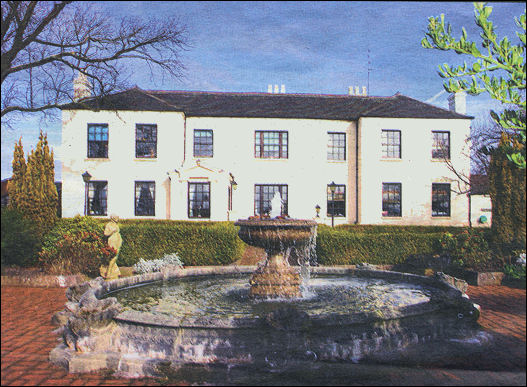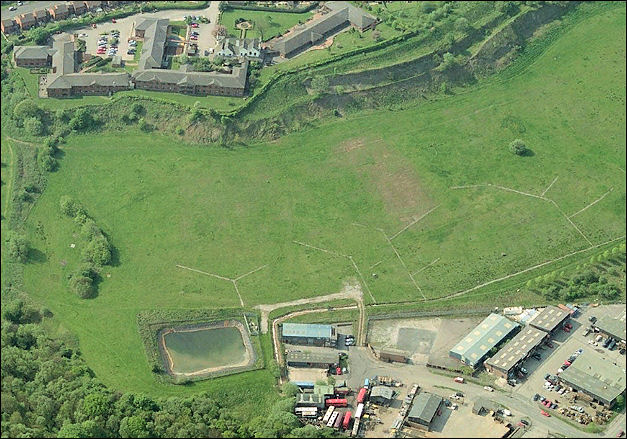|
Bradwell
- 'Sneyds never knew how valuable their land was'
  
click the
"contents" button to get back to the main index & map
next: Trubshaw Cross - major gateway....
previous: Packhorse Lane - the lifeline of the Potteries
|
Historian Fred Hughes
writes....
A map in
historian Steve Birks’ collection shows Brad-Wall as a house on the
western side of a large wood overlooking Tunstall and Burslem.
“We
recognise this area today as Bradwell and Bradwell Wood,” says Steve,
“Once the seat of the Sneyd family who held the estate until present
times. The main flank of the family moved away to the hall at Keele
which became its principal residence in 1581.”
According
to significant research by Dr Christopher Harrison of Keele University,
the first mention of a Sneyd was Henry of Tunstall in 1312. Volume 22 of
North Staffordshire Journal of Field Studies 1982/5 contains a fascinating
account of the origins of one of Staffordshire’s great families.
“The
lineage can be followed from 1312 to 1948; settling first at Bradwell
then Keele,” adds Steve. “Sixty years ago the Sneyd’s sold the entire
estate in order to pay the horrendous death duties accentuated by the
gambling debts of the last Ralph Sneyd of Keele Hall.”
|
This
family’s history is a remarkable narrative of ordinary farmers who,
through connection with the aristocratic Audley’s, clever trading and good
marriages, rose to become aristocrats themselves. A will published on the
death of Richard Sneyd in 1537 describes an extensive manor and house at
Bradwell where they owned all the land they could see for miles around.
“Royalty is introduced from the female line through the marriage of
Ralph Sneyd to Frances Noel in 1690, a descendent of King Edward III and
Queen Phillippa,” says Steve. “This Ralph died in 1695 and his widow
Frances leased Bradwell Hall to the relatively unknown Dutch potters,
the Elers brothers.”
Now why
did the mysterious Elers come to Bradwell.
Steve
suggests, “Pottery in North Staffordshire was in its infancy when the
brothers came to England following the accession of William of Orange in
1688. The brothers were silversmiths from Delft where successful copies of
Chinese teapots were being made. In an age when tea-drinking was a court
craze, a Fulham potter, John Dwight, patented copies of red clay Chinese
teapots. The Ellers brothers followed the trend even though there was some
suggestion they’d stolen Dwight’s patent.”
Attracted
by Bradwell’s red clay the Dutchmen leased Bradwell Hall from the Sneyd’s.
There was also some talk that the decision to live beyond the dense
Bradwell Wood was done to protect themselves from copyists and industrial
espionage. Historian John Ward mentions they were extremely wary of the
local potters and took great steps to keep them at arms distance. And
because of the secrecy the locals were determined to find out what was
going on.
“Paranoid about their privacy the brothers decided to leave
Staffordshire,” continues Steve. “An account of a Burslem potter, who
pretended to be an imbecile when in fact he was spying to collect the
secrets of manufacture, added to the Ellers’ distress. All this
attention sent the reclusive siblings fleeing back to London and
anonymity.”
|
After
the Ellers brothers left, the hall was leased by the Sneyd’s to a
variety of tenants. It was still a large estate when it came into the
possession of a local farmer Ben Twigge who developed the land around the
hall into a factory for crushing aggregates mainly for Shelton Iron and
Steel Company. Bradwell Hall remains in the possession of the Twigge
family to this day. The main building is still an imposing mansion and is
little changed. But the Sneyd land surrounding it has transformed beyond
recognition.

Bradwell Nursing Home
photo: 2008 The Sentinel Newspaper
“I’m not
sure of the chronology of our family’s acquisition but Ben was my
grandfather,” says current owner Edward Twigge. “By the 1980’s the
aggregate business was being run by Ben’s sons, John, David and Graham. It
was then that the local steel industry went into recession and the
aggregates business virtually collapsed. The hall lay unused for awhile
and was subjected to regular vandalism and set on fire. In 1988 the family
decided to bring it back into use and it was developed into the
residential nursing home which it is now.”
Bradwell
Nursing Home accommodates 179 residents, together with 100 place nursery
and is the state of the art in combined-generation community care. With
staff of 260 the home is a major employer in the district. Meanwhile the
old hall has become a standalone reception and admin annex for the
managers Edward and his cousins James, Michael and Julie.
“We
have been lucky,” admits Edward. “Obviously the land and hall were
bought at a time when the Sneyd’s were compelled to sell their estate.
Since then the uncultivated meadows and its ugly clay pits have become
desirable for urban development. The surface of the moon landscape has
been replaced with quality housing, a popular primary school as well as
a stylish community centre. The hall naturally remains the centrepiece
of our business.”
|
To say
that I am jealous of the occupiers of Bradwell hall is an understatement.
The
Sneyd’s certainly knew how to pick a location. Even now the views are
panoramic turning in 180 degrees from Mow Cop and taking in the Bagnall
ridge, Trentham, Hanchurch and Newcastle ending on the western horizon at
the family’s other home, Keele. And inside the old hall a few remnants of
Tudor England grace its 14 rooms together with Georgian moderation and a
dozen other adaptations reflecting changing times and architectural whims.
|

Top left - Bradwell Hall incorporated in the nursing home
top of photo is the outcrop of the Etruria marl and black shale coal
formation
bottom left - the edge of Bradwell wood
bottom right - the location of Metallic Tileries brick works
“One last
thing that should be mentioned,” concludes Steve. “The brick and tile
works known as Metallic Tiles north-west of the hall was operating from
1900, rapidly expanding and doubling in size in 15 years. Now it’s the
giant Ibstock. Here the unique Etruria red-bed clay and Newcastle black
shale came together. Returned to nature part of it has been declared an
SSSI on account of its flora and fauna. It is a key location for British
carboniferous geology. You could say the Sneyd’s never knew just how
wealthy they were.”
next week: Trubshaw Cross
  
click the
"contents" button to get back to the main index & map
next: Trubshaw Cross - major gateway....
previous: Packhorse Lane - the lifeline of the Potteries
 see more on Bradwell
see more on Bradwell |